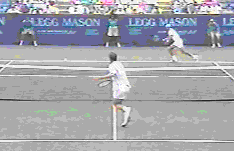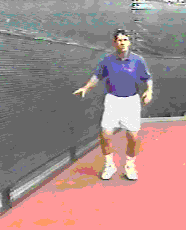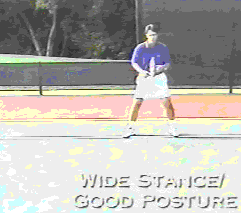|

Secrets of World Class Footwork
by Jim McLennan
Movement
is the Name of the Game
Tennis
is constant motion, sudden starts, stops on a dime - dynamic,
yet balanced, gliding one moment, lunging the next. But with
all the attention paid to high tech racquets, two handed topspin,
and the celebrities in the players' box, it's easy to overlook
the fact that tennis is really all about footwork. Getting to
the ball, (catlike quick), setting up for the hit (balanced),
recovering quickly for the next shot. Movement is the name of
the game - footwork the key.

At regular speed, the Gravity Step is subtle and
difficult to detect. But played in slow motion it's easier to
see the turn as the foot steps away from the ball.
|
Former
Wimbledon, US and Australian Open winner, Stefan Edberg,
renown for catlike quickness and uncommon grace, demonstrates
the gravity step - the special starting technique he uses for extra
quickness and ease of movement about the court.
Study
Stefan's footwork on this dramatic backhand volley winner. He follows the
ball as Rafter is about to make the forehand passing attempt. When Rafter
makes contact Edberg splits his feet wide apart and readies to react to
the shot. As Edberg reads the down the line pass, notice Edberg planting
his right foot and unweighting the left as he turns toward the ball.
Interestingly, Edberg's first step with the left foot is not toward the ball but rather
slightly away from it. Gravity is the initial impulse moving him. As he
steps away he captures a sudden sprinter's start to the ball. This subtle
drop step is the signature of the gravity turn and the secret to Edberg's catlike quickness.
Gravity
Turn

Turning and unweighting my right foot moves me
suddenly to the right - quickly and effortlessly. Because of the
momentum generated, I am forced to catch myself against the fence
to keep from falling.
|
The
Gravity Turn! Lets play with this movement, discover how it feels,
and learn how to use it. In the ready position, the stance is
wide and posture erect. The feeling is light, ready to move, not heavy
or stuck to the ground. Ready now,... waiting,... then reacting quickly,
suddenly pouncing to the ball.
Now watch my footwork (below) as I demonstrate the forehand volley.
Suddenly dropping the right foot moves me quickly to the ball. Drop step,
sprinters start, gravity turn, floating pivot, these are all phrases that capture this
starting technique.
McEnroe relied on this footwork at the net, Seles used it along the
baseline (when she was the dominant number one player in the world),
Fabrice Santoro, the French number 3 who is as quick as anyone
playing the game today, glides quickly about the court with this same
starting technique.
The
Quickest Way to Improve
 Anyone
can learn to hit a good forehand when standing still and waiting
for the ball. But to master the forehand when on the move requires
quick, effortless footwork. The gravity step is the surest way
to improve your tennis. Anyone
can learn to hit a good forehand when standing still and waiting
for the ball. But to master the forehand when on the move requires
quick, effortless footwork. The gravity step is the surest way
to improve your tennis.
Every
player needs to learn the starting move, the quick adjusting
steps prior to the swing, and the quick recovery steps back to
the center of the court in order to return the next shot. Gravity
motion is the key, for truly, if you do not get to the ball,
the adjusting steps, the rhythmic swing, and the recovery just
won't matter.
This
is the first in a series of articles on footwork. The material
is derived from a new video by Jim McLennan, “The Secrets
of World Class Footwork - Featuring Stefan Edberg”.
The gravity turn is presently the subject of a research project at the
Stanford University Biomechanical Engineering laboratory. The results will
be published (in abridged form) on TennisONE.
|